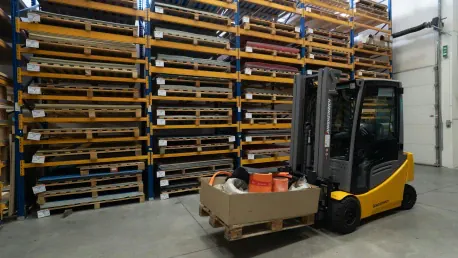In today’s fast-paced and ever-evolving logistics environment, warehouse operations frequently encounter bottlenecks due to unpredictable labor availability and inefficiencies at packing stations. These challenges significantly impede throughput, efficiency, and ultimately, customer satisfaction. The advent of warehouse automation has proven to be a powerful solution to these obstacles, offering a more resilient and flexible operation. Through continuous improvement, warehouse automation is revolutionizing the way bottlenecks are managed, leading to enhanced operational performance.
Identifying Common Bottlenecks
Labor Unpredictability
One of the most notable bottlenecks in warehouse management is labor unpredictability, where daily workforce availability fluctuates, causing inconsistent productivity levels. This variability is often compounded by order unpredictability, involving fluctuations in both order volume and type. On days where operations run smoothly, warehouses may encounter difficulties under a surge of new orders on other days. The inconsistency in labor and order frequency poses significant challenges to maintaining a steady workflow. Warehouses with manual operations can only allocate a limited amount of labor, and once this limit is reached, the throughput experiences a natural cap, further exacerbating these bottlenecks.
Packing and Outbound Processing Challenges
Packing and outbound processing inefficiencies create major choke points that hinder warehouse operations, even if the picking processes are well-optimized. The final stages of order fulfillment can grind to a halt due to manual handling, such as sorting, packing, and preparing shipments for dispatch. The manual allocation of labor to these tasks hits natural limitations, and without streamlined processes, throughput stagnates. These bottlenecks are pain points that need to be addressed for warehouses to operate at maximum efficiency. Automation steps in as a solution to alleviate the strain caused by mechanical processes, allowing for quicker and more reliable processing of outbound operations.
Evolution and Impact of Bottlenecks
The Rise of E-Commerce
The rise of e-commerce has dramatically altered fulfillment operations within warehouses. Different from traditional retail distribution that typically manages bulk orders in large cases, e-commerce demands individualized picking and packing. This personalized approach increases the labor and time required to process each order, adding layers of complexity and intensity to existing bottlenecks. As e-commerce continues to grow, warehouses must adapt to these heightened demands. Individualized picking and packing not only lengthen order processing times but also introduce variability that complicates efficient labor management. As a result, existing operational bottlenecks are further exacerbated, calling for innovative solutions.
Demand Volatility
Demand volatility, highlighted significantly during the COVID-19 pandemic, exposed vulnerabilities within warehouse operations. Unanticipated surges in online orders forced companies to adapt swiftly, creating newfound challenges in forecasting volumes and managing labor efficiently. This volatility continues to be a critical issue post-pandemic as companies strive to handle unpredictable demand fluctuations. The ability to forecast and manage these fluctuations effectively is crucial. Automation provides a strategic solution, enabling warehouses to dynamically adjust operations to meet varying demand levels without experiencing overstaffing or understaffing issues. Addressing demand volatility through automated systems ensures resilience and agility in warehouse operations.
Debunking Automation Misconceptions
Complexity and Cost Concerns
Despite its transformative potential, warehouse operators often possess misconceptions about automation, impeding its widespread adoption. One common belief is that automation is overly complex, expensive, and challenging to implement. Fears of rigid systems that may not adapt to changing business needs can stall decision-making processes, preventing necessary improvements. However, today’s automation solutions are designed with flexibility in mind, catering to evolving business requirements while being cost-effective. Modern automation technologies offer scalable solutions adaptable to varying demand cycles, dispelling the notion that automation is economically prohibitive or overly intricate.
Deployment Fears
Concerns surrounding the deployment of automation systems stem from fears of making incorrect technology choices, leading to decision paralysis and delays in implementing improvements. Operators often worry that automation systems tailored to peak volumes might be underutilized during lower-demand periods, resulting in inefficient resource allocation. However, the latest automation solutions offer dynamic scalability, allowing warehouses to adjust operations based on demand fluctuations seamlessly. These fears can be mitigated by understanding the capabilities of modern automation technologies, ensuring systems are integrated to achieve maximum efficiency across varied demand scenarios.
Measuring Success in Automation
Key Performance Indicators (KPIs)
Evaluating the success of warehouse automation involves measuring both quantitative and qualitative metrics comprehensively. Key performance indicators (KPIs) such as throughput enhancements, labor cost reductions, and order accuracy serve as tangible evidence of automation’s impact. By contrasting pre- and post-automation data, operators can discern the improvements in efficiency and subsequent cost savings achieved. These metrics help in quantifying the direct benefits derived from automation initiatives, demonstrating how automated systems streamline operations and improve productivity metrics, directly contributing to overall business goals.
Qualitative Factors
Qualitative factors also play an essential role in assessing the success of warehouse automation initiatives. Employee retention and job satisfaction are critical markers, as automation often alleviates repetitive and physically demanding tasks. Enhanced ergonomics in the warehouse environment lead to a reduction in safety incidents, further increasing worker well-being. Gamification elements incorporated into automation systems can boost worker engagement and morale. By fostering a more enjoyable and safer workplace, automation positively impacts job satisfaction levels. Such qualitative enhancements, aligned with the quantitative metrics, underscore the comprehensive benefits of automation in warehouse settings.
Role of Data in Optimization
Accountability and Performance Monitoring
Data is the cornerstone of warehouse optimization, ensuring accountability and helping technology providers meet promised outcomes. By harnessing real-time performance monitoring, data-driven insights pave the way for continuous improvement within automated systems. Warehouses can shift from a reactive stance to a proactive strategy through predictive analytics, foreseeing inefficiencies and addressing them before they evolve into bottlenecks. This proactive approach, guided by data accuracy and consistency, allows warehouses to optimize their operations preemptively. It fosters a culture of continuous improvement, ensuring sustainable efficiency and robust performance metrics.
Intelligent Workflow Adjustments
Implementing intelligent workflow adjustments, driven by data, can significantly enhance the efficiency of warehouse operations and prevent bottlenecks from arising. With automation, warehouses can make informed decisions using predictive analytics, ensuring operations are optimized before inefficiencies appear. Real-time adjustments allow for immediate responses to operational changes, maintaining smooth workflows despite demand variability. Such intelligent data integration not only drives efficiency but also supports resilience in operations, ensuring warehouses remain agile and adaptable. Continuous refinement based on data insights facilitates a proactive management style that reduces downtime and sustains productivity.
Traits of High-Performing Warehouses
Strong Site-Level Ownership
High-performing warehouse automation deployments share common traits, beginning with strong ownership at the site level. A dedicated champion leading automation adoption ensures that systems are utilized effectively and continuously optimized. By driving automation initiatives and seeking improvements, these leaders play a critical role in the success of automation projects. Effective site-level ownership entails expertise in automation technologies, commitment to best practices, and a proactive approach towards integrating advancements. Such leadership fosters an environment where automation can thrive, ensuring its benefits are fully realized and sustained.
Dynamic Scalability
The ability to scale dynamically in response to demand fluctuations is vital for high-performing warehouses. Traditional fixed systems often struggle to cope with variability, leaving operators overinvested in infrastructure or unprepared for peak periods. Flexible automation systems, however, enable warehouses to adjust capacity in real-time, maintaining efficiency amid demand volatility. This adaptability ensures warehouses can handle both high and low demand periods without sacrificing performance. Dynamic scalability, coupled with strategic oversight, positions warehouses to achieve maximum operational efficiency and remain resilient. Such flexibility is critical to addressing the challenges posed by fluctuating order volumes and labor availability.
Addressing Barriers to Scalability
Overcoming IT and Integration Challenges
Various barriers can hinder the scalability of warehouse automation, including IT limitations and integration challenges. Organizations that adopt cautious approaches and conduct exhaustive analyses risk missing out on timely opportunities. Excessive analysis may delay deployment, compromising potential efficiency gains. Nevertheless, recent advancements in automation technology offer adaptable and scalable options that reduce risks and accelerate returns on investment. To overcome these integration challenges, it is essential to invest in robust IT solutions and maintain flexible, interoperable systems that support seamless scaling. Continuous adaptation and integration of state-of-the-art technologies ensure that scalability issues are effectively managed, fostering long-term growth.
Partner Selection and Support
Selecting the right warehouse automation partner is a critical step in overcoming scalability barriers. Partners with proven market success, a solid portfolio of ongoing investments, and lifelong customer support can significantly enhance automation implementation. The right partners provide valuable insights, support during deployment, and continuous updates, ensuring systems remain cutting-edge. Comprehensive support and collaboration with skilled partners maximize the benefits of automation investments, making scaling efforts more manageable. By forging strong partnerships, warehouses can navigate challenges effectively, ensuring automation systems are deployed and scaled smoothly, contributing to overall operational efficiency.
Future of Human and Machine Collaboration
Human Oversight
While automation continues to expand its role within warehouse operations, human oversight remains crucial. Automation systems are increasingly taking on responsibilities that were traditionally handled by staff, repositioning employees as managers of these systems to ensure smooth and efficient workflows. Human oversight guarantees that automated systems operate optimally and address issues promptly. This shifting role bridges the gap between human intuition and technological precision, enriching operational management. The collaboration between human capabilities and automated efficiency establishes a comprehensive approach to warehouse management, driving higher productivity levels and operational resilience.
Embracing a Strategic Approach
Companies that incorporate a strategic, data-driven approach to automation can achieve remarkable efficiency gains, transforming warehouse productivity and resilience. Successful deployments serve as testament to automation’s potential, showcasing drastic improvements in units per hour and overall throughput. By leveraging data and embracing innovative automation strategies, companies position themselves to capitalize on modern warehousing advancements. This strategic adaptation ensures sustainable growth and flexibility, enabling warehouses to meet evolving demands seamlessly. Automation, combined with strategic foresight, becomes a powerful tool in optimizing warehouse operations for future success.
Conclusion
In today’s dynamic and rapidly changing logistics landscape, warehouse operations often face significant challenges due to unpredictable labor availability and inefficiencies at packing stations. These issues create serious bottlenecks, hampering throughput and efficiency, and ultimately affecting customer satisfaction. The rise of warehouse automation has emerged as a robust solution to these pressing problems, enabling more resilient and adaptable operations. By implementing continuous improvement, warehouse automation is transforming how bottlenecks are addressed, leading to significantly improved operational performance. This technological advancement allows for streamlined processes, optimal inventory management, and quicker response times to fluctuating demands. As a result, businesses are able to meet customer expectations more effectively while reducing operational costs. Thus, warehouse automation stands as a key driver in revolutionizing the logistics sector, paving the way for a more efficient and customer-centric approach.









